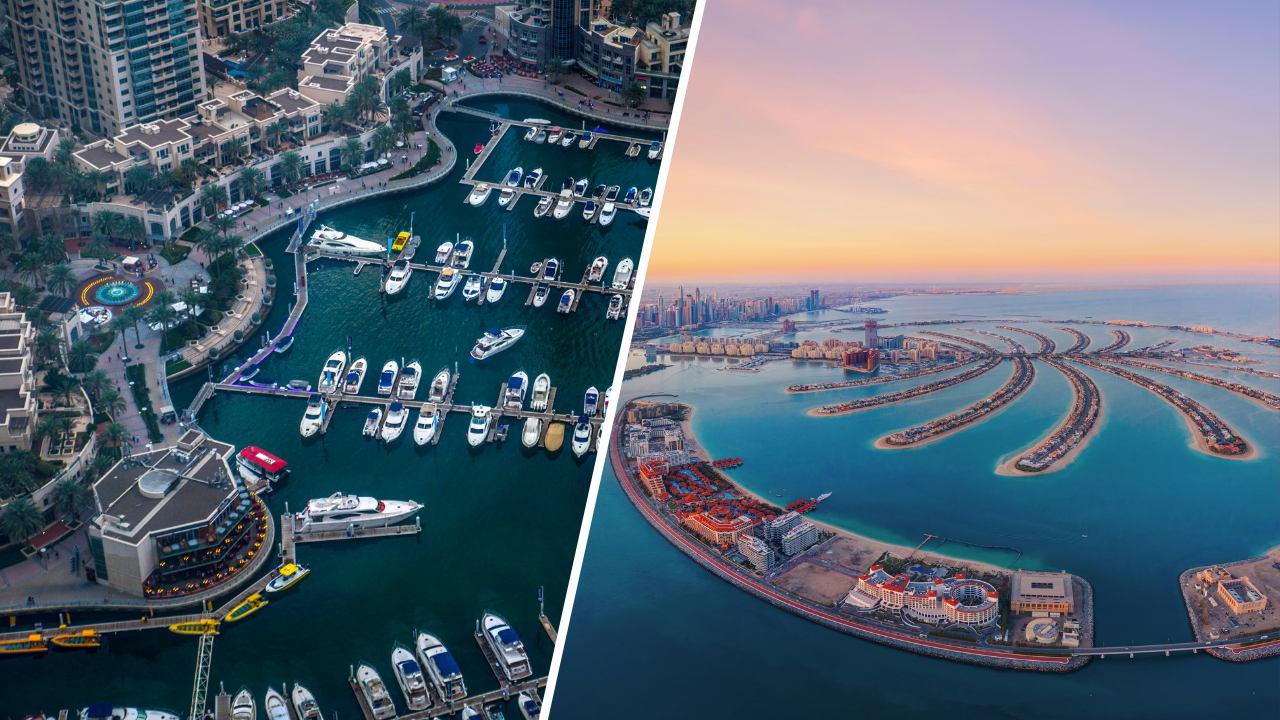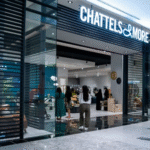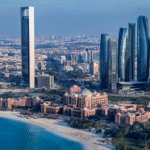Now Reading: Dubai Marina vs Palm Jumeirah: Tax Perks Compared
-
01
Dubai Marina vs Palm Jumeirah: Tax Perks Compared
Dubai Marina vs Palm Jumeirah: Tax Perks Compared

Table of Contents
Imagine owning a sleek apartment overlooking the glittering Dubai Marina or a luxurious villa on Palm Jumeirah’s crescent, with rental income flowing in, untouched by the heavy taxes that erode profits in cities like London or New York. In 2025, Dubai’s real estate market remains a magnet for investors, offering 100% foreign ownership and a tax-friendly environment that outshines global hubs where taxes can claim 15-40% of gains.
The UAE’s dirham, pegged to the U.S. dollar, eliminates currency risk, and residential sales dodge 5% VAT, saving thousands. With a 5% population surge, 25 million tourists, and 8-12% price appreciation expected, both Dubai Marina and Palm Jumeirah deliver 4-6% rental yields, surpassing London (2-4%) or New York (3-4%).
Properties over $545,000 qualify for a 10-year Golden Visa, while smaller units offer 2-year residency perks. This guide compares the tax perks of Dubai Marina and Palm Jumeirah, spotlighting two prime 2025 projects Dubai Marina Coastal Lofts and Palm Jumeirah Sky Villas to help investors choose the best tax-free haven for their wealth-building goals.
Why Dubai’s Tax-Free Zones Attract Investors
Dubai’s real estate market thrives in iconic areas like Dubai Marina and Palm Jumeirah, both 15-20 minutes from Dubai International Airport via Sheikh Zayed Road. With 58% non-resident buyers from countries like the UK, India, and Russia driving 94,000 property transactions in the first half of 2025, these areas boast low vacancy rates (2-3% vs. 7-10% globally) and 4-6% rental yields.
A $2 million property yielding 5% ($100,000 annually) is tax-free for individual landlords, versus $55,000-$70,000 elsewhere after income taxes. Zero capital gains tax saves $80,000-$112,000 on a $400,000 profit. No annual property taxes save $20,000-$40,000 yearly, unlike New York (1-2%) or London (council tax up to 2%).
Residential sales avoid 5% VAT ($100,000), and the 9% corporate tax doesn’t apply to individual landlords. Free zone companies save $1,000-$30,000 annually, and small business relief waives corporate tax for revenues under $816,000 until December 31, 2026. Both locations leverage these tax perks, but their unique lifestyles and investment profiles set them apart.
The tax-free structure makes investing in either location feel like a financial win.
Dubai Marina: Urban Vibrancy Meets Tax-Free Gains
Dubai Marina, a bustling waterfront hub, blends urban energy with tax-free investment appeal. Its skyline of towering apartments and proximity to retail and dining make it a favorite for professionals and expatriates. The area’s 3% vacancy rate and high demand from 25 million annual tourists drive strong rental yields.
Dubai Marina Coastal Lofts: Tax-Free Urban Gem
Coastal Lofts by Emaar, set for completion in Q3 2025, offer 4-6% rental yields and 8-12% price growth. Featuring 1-3 bedroom apartments ($816,750-$2.04 million), these 800-2,200 square foot units boast marina views and smart designs. A $1.2 million apartment yields $48,000-$72,000 tax-free annually, versus $26,400-$43,200 elsewhere after income taxes. With 25% growth, selling it for $1.5 million yields a $300,000 tax-free profit, saving $60,000-$84,000 in capital gains tax compared to London or New York. No annual property taxes save $12,000-$24,000 yearly, and VAT exemption on residential purchases saves $60,000.
Initial costs include a 4% Dubai Land Department (DLD) fee ($32,670-$81,675), 2% broker fee ($16,335-$40,838), and a 50/50 payment plan. Annual maintenance fees are $5,000-$12,000, and landlords pay a 5% municipality fee ($2,400-$3,600). A Qualified Free Zone Person (QFZP) free zone company saves $12,240-$18,360 on $122,400-$183,600 in rental income.
U.S. investors deduct depreciation ($21,818-$43,636) and management fees ($2,236-$5,091), saving up to $17,455 annually. Properties over $545,000 qualify for a 10-year Golden Visa, while smaller units offer a 2-year visa. Short-term rentals, leveraging tourist demand, boost yields by 10-20% with Department of Tourism and Commerce Marketing (DTCM) registration ($408-$816 annually).
The urban, waterfront vibe of Dubai Marina feels like a dynamic, tax-free retreat.
Palm Jumeirah: Exclusive Luxury with Tax-Free Perks
Palm Jumeirah, the iconic palm-shaped island, is synonymous with exclusivity and waterfront luxury. Its private beaches and low 2% vacancy rate attract affluent buyers and tenants, making it a top choice for high-net-worth investors seeking tax-free returns.
Palm Jumeirah Sky Villas: Tax-Free Waterfront Haven
Sky Villas by Nakheel, set for completion in Q2 2025, offer 4-6% rental yields and 8-12% price growth. Featuring 4-6 bedroom villas ($3 million-$6 million), these 4,000-6,000 square foot homes boast private beaches and smart systems. A $4 million villa yields $160,000-$240,000 tax-free annually, versus $88,000-$144,000 elsewhere. With 25% growth, selling it for $5 million yields a $1 million tax-free profit, saving $200,000-$280,000 in capital gains tax. No annual property taxes save $40,000-$80,000 yearly, and VAT exemption saves $200,000.
Initial costs include a 4% DLD fee ($120,000-$240,000), 2% broker fee ($60,000-$120,000), and a 20/50/30 payment plan. Annual maintenance fees are $15,000-$25,000, and landlords pay a 5% municipality fee ($8,000-$12,000). A QFZP saves $40,800-$61,200 on $408,000-$612,000 in rental income. U.S. investors deduct depreciation ($72,727-$109,091) and management fees ($7,455-$14,545), saving up to $36,364. Golden Visa eligibility applies. Short-term rentals boost yields by 10-20% with DTCM registration. The 2% vacancy rate ensures steady demand from elite tenants.
The beachfront exclusivity feels like a tax-free, high-return paradise.
Tax Perk 1: No Annual Property Taxes
Both Dubai Marina and Palm Jumeirah benefit from Dubai’s zero annual property tax policy, unlike New York (1-2%) or London (council tax up to 2%). For a $1.2 million Dubai Marina Coastal Loft, owners save $12,000-$24,000 yearly, while a $4 million Palm Jumeirah Sky Villa saves $40,000-$80,000. Maintenance fees ($5,000-$12,000 for Marina, $15,000-$25,000 for Palm) and a 5% municipality fee ($2,400-$12,000) are the primary ongoing costs. This tax-free advantage allows investors to reinvest savings or elevate their lifestyle.
Saving thousands yearly feels like a financial gift that keeps giving.
Tax Perk 2: Zero Capital Gains Tax
Dubai’s zero capital gains tax benefits both locations equally. Selling a $1.2 million Dubai Marina Coastal Loft for $1.5 million after 25% appreciation yields a $300,000 tax-free profit, saving $60,000-$84,000 compared to London or New York. For a $4 million Palm Jumeirah Sky Villa sold at $5 million, the $1 million profit saves $200,000-$280,000. This tax-free gain makes both areas attractive for long-term wealth growth, with Palm Jumeirah’s higher price points offering larger absolute savings.
Keeping every dirham of your profit feels like a financial superpower.
Tax Perk 3: No Income Tax on Rentals
Individual landlords in both Dubai Marina and Palm Jumeirah pay no personal income tax on rental earnings, unlike the U.S. (up to 37%) or UK (up to 45%). A $1.2 million Dubai Marina Coastal Loft yielding $48,000-$72,000 annually keeps every dirham, versus $26,400-$43,200 elsewhere. A $4 million Palm Jumeirah Sky Villa yielding $160,000-$240,000 saves $88,000-$144,000. Long-term leases require Ejari registration ($54-$136 annually), while short-term rentals, boosting yields by 10-20%, need DTCM registration ($408-$816). The tax-free rental income is identical, but Palm Jumeirah’s higher yields offer greater absolute returns.
Tax-free rent feels like a monthly boost to your wealth.
Tax Perk 4: VAT Exemption on Residential Purchases
Residential purchases in both areas are exempt from 5% VAT, unlike commercial properties. Buying a $1.2 million Dubai Marina Coastal Loft saves $60,000, while a $4 million Palm Jumeirah Sky Villa saves $200,000, compared to the UK’s stamp duty (up to 12%, or $144,000-$480,000).
Off-plan purchases may incur 5% VAT on developer fees ($20,000-$80,000), recoverable via Federal Tax Authority (FTA) registration ($500-$1,000). Short-term rental operators must register for VAT if annual revenue exceeds $102,041, charging 5% on bookings but claiming input tax credits on expenses like utilities or DTCM fees. The VAT benefit is equal, but Palm Jumeirah’s higher price points amplify savings.
The VAT exemption feels like a warm welcome to property ownership.
Tax Perk 5: Free Zone and U.S. Tax Benefits
Both locations allow investors to set up a QFZP free zone company, saving $12,240-$61,200 annually on $122,400-$612,000 in rental income, with setup costs of $2,000-$5,000 and annual fees of $1,000-$3,000. Small business relief waives corporate tax for revenues under $816,000 until 2026. U.S. investors in either area deduct depreciation ($21,818-$109,091), maintenance ($5,000-$25,000), and mortgage interest on Schedule E, saving up to $36,364 annually.
Non-U.S. investors benefit from double taxation treaties with 130+ countries, avoiding taxes like the UK’s 20-28% capital gains tax. These benefits are identical for both areas, though Palm Jumeirah’s higher rental income maximizes free zone savings.
These tax strategies feel like a clever way to amplify returns.
Comparing Costs of Ownership
Buying a $1.2 million Dubai Marina Coastal Loft incurs a 4% DLD fee ($48,000), 2% broker fee ($24,000), and a 10% deposit ($120,000). A $4 million Palm Jumeirah Sky Villa incurs a 4% DLD fee ($160,000), 2% broker fee ($80,000), and a 10% deposit ($400,000). Flexible payment plans (50/50 for Marina, 20/50/30 for Palm) spread costs, with 50-70% paid during construction.
Annual maintenance fees are $5,000-$12,000 for Marina and $15,000-$25,000 for Palm, with municipality fees of $2,400-$3,600 and $8,000-$12,000, respectively. Short-term rentals require DTCM registration ($408-$816), while long-term leases need Ejari registration ($54-$136). Off-plan purchases may incur 5% VAT ($20,000-$80,000), recoverable via FTA registration. Palm Jumeirah’s higher costs reflect its premium positioning.
These costs feel like a small price for tax-free, high-return potential.
Dubai Marina vs. Palm Jumeirah: Key Differences
Dubai Marina offers urban vibrancy, lower entry prices ($816,750-$2.04 million), and strong demand from professionals and tourists, making it ideal for investors seeking accessible, high-yield properties. Its 3% vacancy rate and short-term rental potential (10-20% yield boost) suit dynamic portfolios. Palm Jumeirah, with its exclusive villas ($3 million-$6 million), appeals to high-net-worth buyers seeking luxury and privacy, with a 2% vacancy rate and larger tax-free savings due to higher price points.
Both offer identical tax perks no income tax, no capital gains tax, no property tax, and VAT exemptions—but Palm Jumeirah’s higher rental income ($160,000-$240,000 vs. $48,000-$72,000) and capital gains amplify absolute returns. Dubai Marina is better for budget-conscious investors, while Palm Jumeirah suits those prioritizing prestige and larger profits.
Choosing between them feels like picking between vibrant energy and serene luxury.
Strategies to Maximize Tax-Free Returns
To optimize returns in either location, use these strategies. First, target high-yield projects like Dubai Marina Coastal Lofts or Palm Jumeirah Sky Villas (4-6%). Second, leverage short-term rentals for 10-20% yield boosts, ensuring DTCM compliance. Third, set up a QFZP free zone company to save $12,240-$61,200 annually. Fourth, recover 5% VAT on off-plan purchases.
Fifth, leverage small business relief for revenues under $816,000 until 2026. Sixth, U.S. investors should deduct depreciation, maintenance, and mortgage interest on Schedule E. Hire a property manager ($5,000-$25,000 annually) for ease. Consult a tax professional for compliance.
Navigating Risks for Smart Investing
Risks include a projected oversupply of 41,000 units in 2025, potentially slowing price growth. Mitigate by choosing trusted developers like Emaar or Nakheel, verifying escrow compliance under the 2025 Oqood system for off-plan buys, and targeting high-demand projects with low vacancies (2-3%). Ensure QFZP eligibility to avoid fines up to $136,125. Long-term leases in Dubai Marina ensure stability, while short-term rentals in Palm Jumeirah boost yields. Proximity to key hubs and global demand drive value. Regular market analysis keeps you ahead.
Why Dubai Marina and Palm Jumeirah Are Top Picks
Dubai Marina Coastal Lofts offer urban vibrancy and accessible tax-free returns, while Palm Jumeirah Sky Villas deliver exclusive luxury with larger tax-free profits. Both benefit from no annual property taxes, zero capital gains tax, tax-free rental income, and VAT exemptions, making them prime choices for 2025.
With 4-6% yields, 8-12% price growth, and Golden Visa perks, these projects cater to different investor profiles Marina for dynamic, urban-focused portfolios and Palm for prestigious, high-value wealth-building offering a tax-free lifestyle in Dubai’s iconic hubs.
read more: Tax-Free Zones in Dubai’s Island Projects Attracting Global Buyers






















